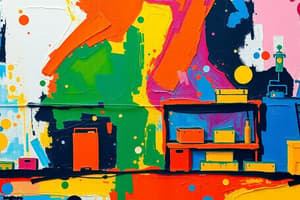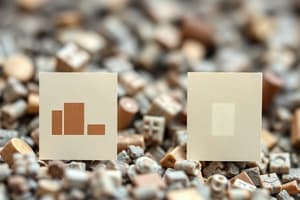Podcast
Questions and Answers
What is the primary focus of microeconomics?
What is the primary focus of microeconomics?
- Economic growth and inflation
- Government fiscal policies
- The overall performance of the economy
- Individual agents such as consumers and firms (correct)
Scarcity refers to the unlimited availability of resources in an economy.
Scarcity refers to the unlimited availability of resources in an economy.
False (B)
What is the measure of total demand for goods and services in an economy called?
What is the measure of total demand for goods and services in an economy called?
Aggregate demand
The ______ measures the total value of goods and services produced in a country.
The ______ measures the total value of goods and services produced in a country.
Match the following economic concepts with their definitions:
Match the following economic concepts with their definitions:
Flashcards
Economics
Economics
The social science studying how societies allocate scarce resources to satisfy unlimited wants and needs.
Microeconomics
Microeconomics
Study of how individual consumers, firms, and industries make decisions in a market.
Macroeconomics
Macroeconomics
Study of the overall performance of an economy including aggregate variables like inflation and unemployment.
Supply and Demand
Supply and Demand
Signup and view all the flashcards
Gross Domestic Product (GDP)
Gross Domestic Product (GDP)
Signup and view all the flashcards
Study Notes
Introduction to Economics
- Economics studies how societies allocate scarce resources to meet unlimited wants and needs.
- It includes the production, distribution, and consumption of goods and services.
- Key concepts include scarcity, opportunity cost, supply and demand, and market equilibrium.
- Two major branches are microeconomics and macroeconomics.
Microeconomics
- Focuses on individual agents (consumers, firms, industries).
- Examines decision-making under scarcity.
- Key concepts:
- Supply and demand: Interaction between producer supply and consumer demand at various prices.
- Elasticity: Measures how responsive one variable is to changes in another (price elasticity of demand, income elasticity).
- Market structures: Perfect competition, monopoly, oligopoly, monopolistic competition.
- Production and cost: Optimal output for profit maximization.
- Consumer behavior: Factors influencing consumer choices.
- Externalities: Costs or benefits impacting third parties.
Macroeconomics
- Studies the overall economy, including inflation, unemployment, and growth.
- Examines aggregate demand and supply.
- Analyzes government policies (fiscal and monetary) to influence the economy.
- Key concepts:
- Gross Domestic Product (GDP): Total value of goods and services produced.
- Inflation: General price increases.
- Unemployment: Percentage of unemployed labor force.
- Economic growth: Increase in production over time.
- Business cycles: Alternating periods of expansion and contraction.
Key Economic Schools of Thought
- Different schools (Keynesian, classical, monetarist) offer varied perspectives on how economies operate and how to manage them.
- Keynesian economics emphasizes government intervention during recessions.
- Classical economics highlights market self-regulation.
- Monetarism focuses on money supply's impact on inflation.
Economic Systems
- Market economies: Decisions driven by supply and demand, with minimal government intervention.
- Command economies: Centrally planned economies, with significant government control.
- Mixed economies: Combine elements of market and command economies, often including government regulation.
Tools for Economic Analysis
- Graphs: Visual representations of economic relationships (supply/demand curves, production possibilities frontiers).
- Mathematical models: Quantify relationships and test theories, using equations.
- Statistical methods: Interpret data about economic phenomena.
Policy and Applications
- Governments use economic theories and models to create policies (taxation, spending, trade) to influence the economy and meet societal goals (like growth).
- Policy effectiveness depends on understanding the impact on different groups.
Studying That Suits You
Use AI to generate personalized quizzes and flashcards to suit your learning preferences.




